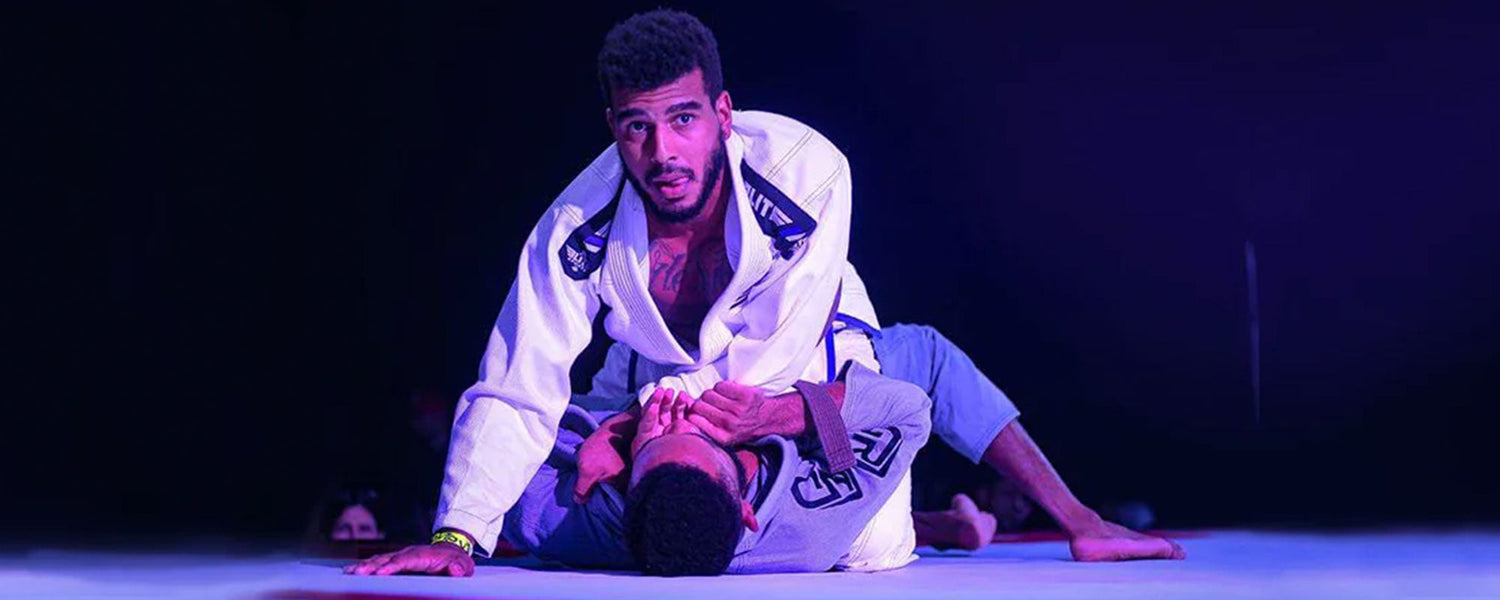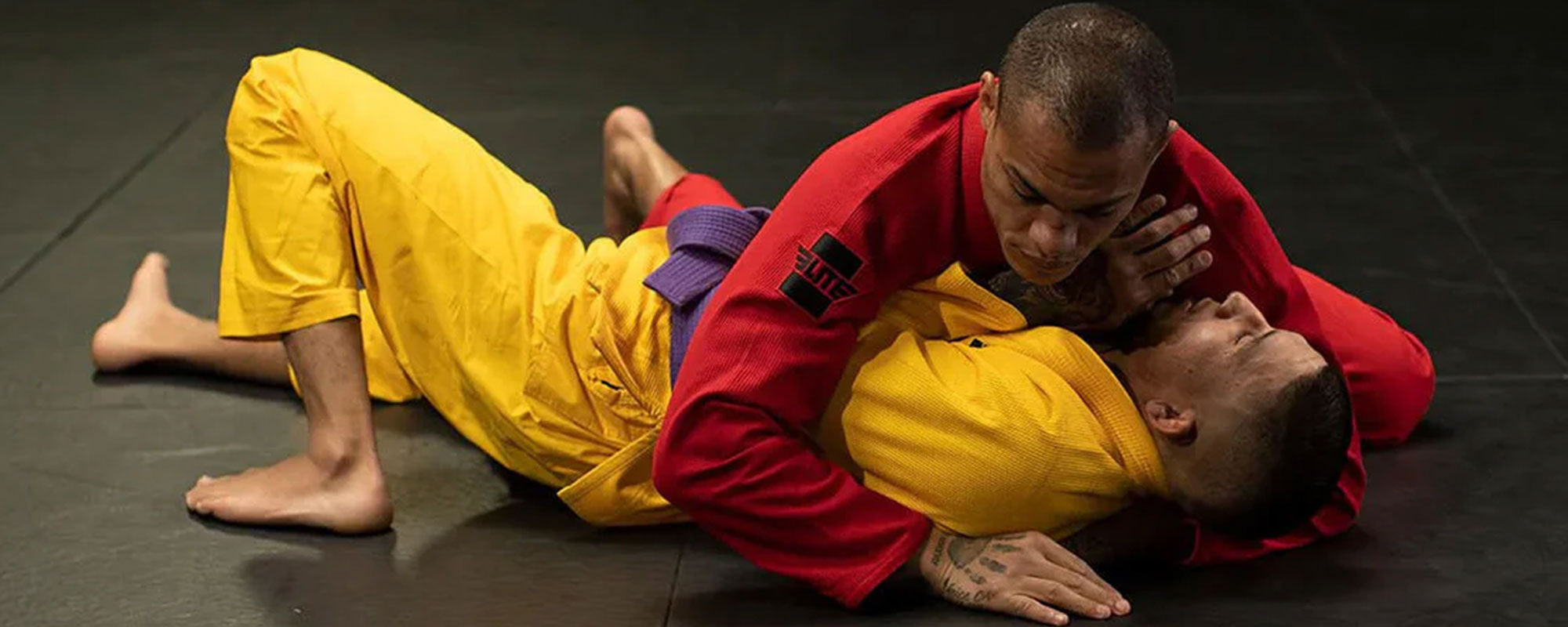Table of content
Mount position is a total game-changer in BJJ. No matter if your opponent is stronger or experienced than you, if you manage to get them in mount then you have a high chance to make them submit.
If we consider BJJ a game of chess then there is no doubt that mount is a position of checkmate if combined with submissions.
In our series of mounts, here we will be discussing how to execute the position, retain it and escape if you are caught in a high mount.
High Mount: BJJ Position
In a high mount, your focus is on controlling the chest of your opponent by sitting on their belly or lower chest instead of the thighs in the case of a simple mount.
This position could be a bit tricky especially for beginners because you are putting your body into a vulnerable position. And, can be swept if it’s not executed properly.
But at the same time, the high mount can get you closer to submitting your opponent.
Just as the technical mount and knee mount, for getting a high mount position first you need to get a simple mount.
A high mount cannot be escaped easily because it’s almost impossible to try out some defensive moves when your opponent will be gasping for air.
Some people confuse the high mount with the guard position, this makes them think that you should never try a high mount to submit your partner.
But, in a guard position, the bottom person has the advantage of using his legs for protection.
Whereas in a full mount position the opponent can’t use his legs because they are immobilized.
The most common technique for getting in a high mount is through a simple mount.
As you try to move your body forward towards the chest of your opponent, he will try stopping you by pushing your thighs.
To stop this, pull up the right elbow of your opponent using your hand and put pressure using the left knee
.
Do the same thing with the other side and you will land onto the chest of your opponent.
Now you can hook behind their neck and put your other hand on the top to stop their momentum.
Establishing control in a high mount consists of basic steps. If you can execute them properly then, you will be able to develop perfection in a high mount.
1. Retaining a High Mount
Maintaining a high mount is not the easiest thing in the world. It requires strength but more than those effective skills are necessary.
Keeping in view the key points such as balance, foot positioning, flexibility, and much more. There are some exceptional techniques for retaining a high mount.
1.1. Sticking Your Feet
When you are in a high mount, the first thing you need to do is climb up as much as possible.
But your opponent will stop you by pushing your chest back using their hands. To add more stabilization to your body, you can take advantage of your feet.
What you need to do is to stick your feet below the knees of your opponent and push their calves. This will decrease the impact of your opponent’s pushing.
Another variation in this technique is to cross your feet like you are locking the guard. It would be harder for the opponent to push your leg as they are locked together.
Push your locked feet tightly towards your opponent’s hip bone.
Even if the opponent is trying to push your leg, they will just be pushing down on their hip and can’t move you.
1.2. Blocking Head
When you are in a high guard against your opponent and they can’t push you back, the next escape they would try is to scoop up.
But if you have developed the basic skills of retaining a high mount then you can stop this as well.
To stop this, you need to block the top of their head by putting pressure on it.
Make sure that your thighs are pushing against the arms of your opponent so that he doesn’t have enough force to scoop up or push you back.
It can work most of the time. The only problem is that for opening the arms of your opponent, you need to let go of their head. They can take advantage of this situation and scoop up.
1.3. Technical Mount
Although amount is a very tough position in jiu-jitsu, the technical mount just takes this position to another level. It is also known as s-mount or side mount.
Technical or side mount is different from side control.
This is mostly used to counter the common high mount escapes such as bridging or elbow-knee escape.
The technical mount also puts you in a good attacking position, there are several submissions you can try from this position.
To get into this position, let’s imagine that first, you have successfully ended up in the high mount position.
Your opponent will most probably use his hands to defend himself, use this opportunity to grab the collar of his Gi with your right hand.
Now roll your body and put your left knee close to your opponent’s ear.
But if your opponent has crossed their arms and you can’t grip their collar?
Then you can drop your chest and begin to walk up by pushing their armpits from your biceps.
Try to climb up as much as possible and then roll your knee just as before.
2. Escaping High Mount
Escaping from any kind of mount is not something that you will learn in your first few classes as a beginner. The high mount is a strong position for the person on top so it poses some problems with the escape.
You can’t use the elbow or hip bridge escape effectively because it’s hard to move the center of gravity if the opponent is sitting too high.
Your arms and neck are exposed, the opponent can throw in a submission any time. You can’t sweep the opponent because their knees and ankles aren’t accessible.
2.1. Knee Escape
Knee escape is a useful technique for escaping a simple or low mount because you can roll your knee against the opponent’s leg.
But in the case of the high mount, your opponent’s leg is not approachable so the knee escape is not that easy.
So, what you do here is grab your opponent’s right leg with your left hand and lift it.
Now slide your right leg against their right leg to set your leg free. And push their legs away to escape backward.
2.2. Foot Drag Escape
This is another method for escaping your legs when trapped in a high mount by your opponent.
Start with grabbing the left foot of your opponent with your right hand and pull his leg downward.
Now, cross his leg using your left leg. And, hook the opponent’s foot with yours.
Push back your opponent’s leg and drag your body backward, or you can also end up in a guard position.
2.3. Escape by hip shift
You can use this method to escape a high mount when your opponent has his hands on the mat behind your head.
Most people try to lift the right hand of the opponent to escape but that is not the right way of doing it.
Turn to the left side of your opponent and push their left arm at the elbow. Don’t try to grab the elbow, only push it to the opposite side.
Grab the belt of your opponent from the back and sweep them by lifting your hips.
The key point is to start by hip shift, step out your leg and shift your body to the left of your opponent. If you don’t do that then you won’t have enough movement.
3. High Mount Submissions
After you have successfully scored the point for a high mount, your next target would be to submit your opponent.
You can throw a lot of submissions from the high mount, we will be discussing a few bests of them over here.
3.1. Armbar Submission
Armbar is an effective submission from high mount. It is done by getting into a technical mount or the S-mount but to get there, you need to start from a high mount.
Follow the steps discussed above to establish a technical mount from the high mount.
Cross grip the elbow of your opponent against your knee and grab his hand from the wrist.
Now you can apply pressure on their arm to make them submit.
3.2. Crossed Armbar Submission
Another variation in the armbar submission is to apply the armbar when your opponent has crossed his arms strongly and you can’t pull his arm out.
For this submission, reach up as much as possible and pinch the opponent’s elbows using your knees.
And, drop your stomach on his elbows.
Now, you can hook the arm of your opponent and pull it back to submit him using the armbar.
The trick in this submission is to stay forward and grab the opponent’s arm from under the hook. If you pull your body back, you will just end up falling backward and losing the high mount position.
3.3. Triangle Choke
Just like the triangle choke in a simple mount, you can also submit your opponent by choking his neck through the triangle arm choke.
Underhook the opponent’s neck using your left hand, and your right arm should be under the opponent’s left arm.
Walk your arm little by little against your opponent’s arm, your objective should be that the opponent’s arm is near your ear.
Once that’s established, you can slide their arm down across your hands to improve your grip.
Now lift your lower body like in a tripod position, and move your body across their belly to the left side.
Keep moving your body until they tap out.













Leave a comment
This site is protected by hCaptcha and the hCaptcha Privacy Policy and Terms of Service apply.